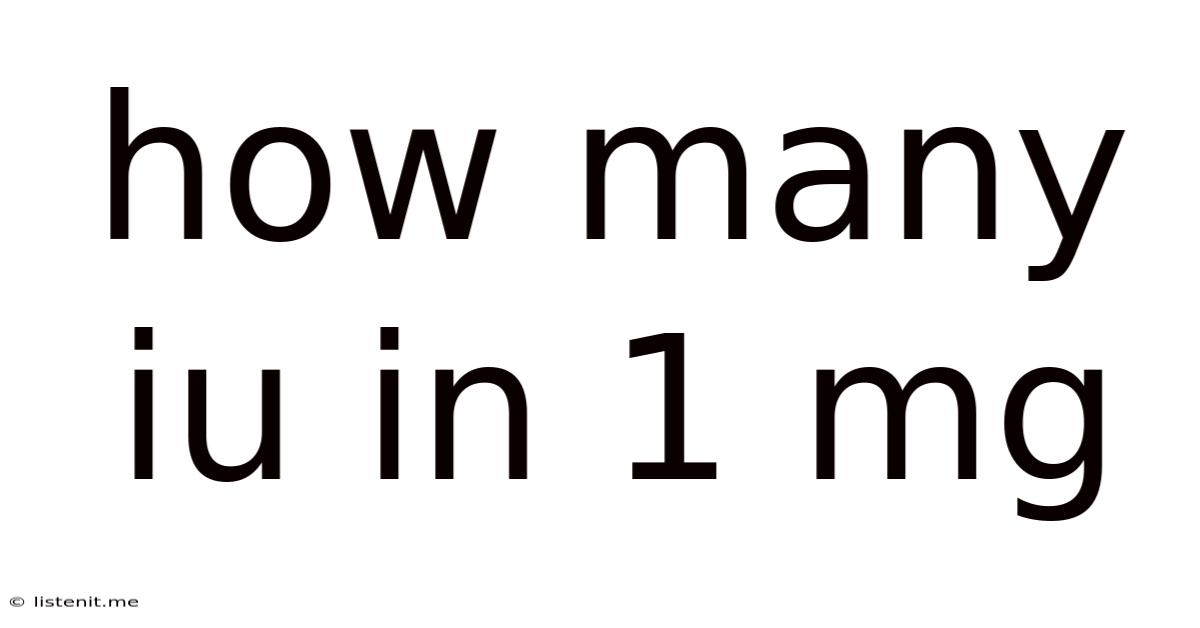How Many Iu In 1 Mg
listenit
May 12, 2025 · 4 min read

Table of Contents
How Many IU in 1 mg? Understanding International Units and Milligrams
The question, "How many IU in 1 mg?" doesn't have a simple, universal answer. This is because International Units (IU) and milligrams (mg) are two different units of measurement that express different things. IU measures biological activity, while mg measures weight or mass. The conversion factor between IU and mg varies dramatically depending on the specific substance being measured. This article will delve into the complexities of this conversion, exploring why a direct conversion isn't possible and providing examples to illustrate the variability.
The Difference Between IU and mg: A Crucial Distinction
Before we attempt to tackle the conversion, it's crucial to understand the fundamental difference between IU and mg:
-
Milligrams (mg): A unit of mass in the metric system. It represents a specific weight of a substance. 1000 mg equals 1 gram (g). This is a straightforward and universally consistent measure. Measuring a substance in mg tells us how much of the substance is present by weight.
-
International Units (IU): A unit of measurement used to express the biological activity of a substance. It's not a measure of weight but of the effect the substance has. The amount of a substance required to produce a specific biological effect is defined as 1 IU. This definition varies widely depending on the substance and the specific biological effect being measured. This makes direct comparison with mg impossible without specific reference to a defined standard.
Why There's No Universal Conversion Factor
The lack of a universal conversion factor stems from the inherently different nature of the two units. Imagine trying to convert the sweetness of a sugar cube (measured by a subjective taste test) into grams of sugar. It's not possible without first defining the specific sweetness level as a reference point. Similarly, converting IU to mg necessitates knowing the specific substance and the defined biological activity associated with 1 IU.
Examples Illustrating the Variability
Let's examine several examples to highlight the variability in the IU to mg conversion:
1. Vitamin A (Retinol)
Vitamin A is often expressed in both IU and µg (micrograms). A common conversion factor is that 1 IU of retinol is approximately equivalent to 0.344 µg of retinol. Since there are 1000 µg in 1 mg, you can calculate an approximate conversion:
- 1 IU Vitamin A ≈ 0.344 µg ≈ 0.000344 mg
Therefore, there are approximately 2900 IU in 1 mg of retinol. However, it's crucial to note that this conversion depends on the specific form of Vitamin A (retinol, retinal, retinoic acid) and might vary slightly depending on the source.
2. Vitamin D
Vitamin D, another fat-soluble vitamin, also presents a different conversion scenario. The IU to mg conversion for Vitamin D3 (cholecalciferol) is approximately:
- 1 IU Vitamin D3 ≈ 0.025 µg ≈ 0.000025 mg
This means there are roughly 40,000 IU in 1 mg of Vitamin D3. This is considerably different from the Vitamin A conversion.
3. Vitamin E
Vitamin E, another fat-soluble vitamin, is often expressed in IU. The conversion varies based on the specific tocopherol or tocotrienol isomer. For alpha-tocopherol, a common conversion is:
- 1 IU Vitamin E (alpha-tocopherol) ≈ 1 mg
In this case, the conversion is relatively straightforward. One IU is roughly equivalent to 1 mg. However, other isomers of vitamin E might have different conversions.
4. Insulin
Insulin, a crucial hormone for blood sugar regulation, is another substance where IU is used. The IU of insulin is defined by its hypoglycemic activity – its ability to lower blood sugar levels. The exact conversion from IU to mg for insulin depends on the specific insulin formulation (e.g., human insulin, analogs). You cannot simply determine the mg equivalent from the IU alone.
The Importance of Consulting Product Labels and Medical Professionals
Because of the significant variability in IU to mg conversions, it's crucial to consult the product label of any supplement or medication you're taking. The label will clearly state the amount of the substance in both IU and mg, if applicable, and provide the specific conversion factors applicable to that particular product.
Furthermore, consulting with a healthcare professional or registered dietitian is highly recommended, especially when dealing with vitamins and medications. They can provide personalized advice based on your individual needs and health conditions. They can also help you understand the implications of different dosage forms and ensure you're taking the appropriate amount of the substance for optimal health.
Conclusion: Context is Key
The question, "How many IU in 1 mg?" doesn't have a single answer. The conversion is highly dependent on the specific substance in question and the defined biological activity associated with one IU. It's essential to understand the distinction between IU and mg and the limitations in direct conversion. Always refer to product labels and consult healthcare professionals for personalized advice on dosage and appropriate use of substances measured in IU. Never attempt to convert IU to mg without specific information from a reliable source. Misinterpretations could have significant health implications. Therefore, accurate information and professional guidance are crucial when dealing with units like IU and mg. Remember, always prioritize your health and safety by seeking professional advice when needed.
Latest Posts
Latest Posts
-
Number Of Chromosomes In Fruit Fly
May 12, 2025
-
How Many Terms Are In The Following Polynomial
May 12, 2025
-
What Is The Decimal Of 1 20
May 12, 2025
-
Why Metals Are Good Conductors Of Heat And Electricity
May 12, 2025
-
A Metal That Is A Liquid At Room Temperature
May 12, 2025
Related Post
Thank you for visiting our website which covers about How Many Iu In 1 Mg . We hope the information provided has been useful to you. Feel free to contact us if you have any questions or need further assistance. See you next time and don't miss to bookmark.